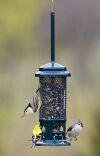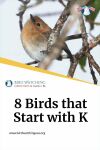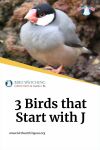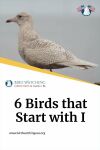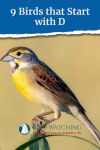
Introduction
Hey there, bird lover! Did you know that out of the 750 most common birds in the USA & Canada, there are only 9 birds that start with the letter D? That’s around 1.2% only! Out of all those species, you’ll find some amazing grouses, ducks, and even woodpeckers!
Well, guess what? This post is all you need as your ultimate guide. I have arranged the common birds that start with D in descending order - all according to how common they are in the USA & Canada. Credit for the information goes to the lovely people at EBirds where bird lovers (like us) are able to add the birds they see in a list. Thanks to their data, I could list these birds from the highest percentage of the population to the ones that are least likely to be seen.
So here’s the list, in case you want to have a quick look!
| Downy Woodpecker | 23.76% |
|---|---|
| Dark-eyed Junco | 18.03% |
| Double-crested Cormorant | 12.08% |
| Dunlin | 1.32% |
| Dickcissel | 0.90% |
| Dusky Flycatcher | 0.29% |
| Dusky-capped Flycatcher | 0.10% |
| Dusky Grouse | 0.03% |
| Dovekie | 0.01% |
But if you want to feel up close and personal with every bird on the list, below are the details along with breathtaking pictures. Personally, my favorite is #9, why not have a look at it?
1. Downy Woodpecker
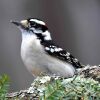
We have a woodpecker for a winner! The Downy Woodpecker beats the rest as the most common bird starting with D in the United States and Canada. You can bet that the Downy Woodpecker would make an appearance now or again. Although forests are their natural habitat, you can spot these woodpeckers in your backyard too. That’s just where I happened to find my very first Downy Woodpecker during backyard birdwatching. They even nest on the walls of buildings, so you can say they’re habitual of the city life too.
But it wasn’t only the sight of this black-and-white tiny bird that had caught my attention at first. It was the high-pitched voice that made me curious about the whining call. It was thrilling to hear because these birds don’t sing songs yet make rhythms out of pecking on wood.
You’d also be surprised to know that the Downy Woodpecker is the tiniest in North America. But while being the smallest may sound cute, they have quite a short life span like other small birds. With a life of only around a year or so, these small birds don’t last long.
And behold the most amazing and fun fact of this bird. These woodpeckers have feathered protection around their nostrils. So there’s no chance of inhaling wood chips while they peck away!
PRO-TIP
GET A BIRDFEEDER
I had a birdfeeder installed too, which made it easier to invite this tiny bird into my backyard.
If you don’t have a bird-feeder yet, here’s one that I highly recommend.
Standard Squirrel-Proof Bird-Feeder
This bird-feeder has a 1.3-pound seed capacity. Black oil sunflower or safflower seeds
2. Dark-eyed Junco
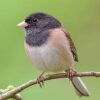
On #2 is the Dark-eyed Junco bird, that’s very abundant in North America! They’re all over the continent especially during the winter, when they’re in open environments such as parks and gardens.
The Dark-eyed sparrow is a medium-sized small-greyish sparrow species that isn’t easy to spot. But I was able to find one thanks to its long tail and the bright white feathers that were clearly visible in its flight mode!
These birds eat seeds most of the time. But their diet also consists of around 25% other material such as insects. These could be anything from butterflies and moths to even beetles, ants, wasps, caterpillars, and flies. They often do a food hunt on the ground, hopping around and looking below twigs and leaves for a meal. I had even spotted one of them in a park, flying towards a tree trunk just to catch an insect for an appetizer.
Another fact: The females do all the nest building! They use their tiny bodies to give the nest its shape and the style of the nest depends on the environment in which it is built.
did you know?
males with more white feathers preferred
When a male dark-eyed junco courts a female, they hop up and down and even open their wings and fan their tails. But that's not all, they add moss or other nest material to their performance. You'll also be surprised to know that female dark-eyed juncos root for males that have more white in their feathers. Isn't that interesting?
3. Double-crested Cormorant
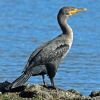
With their long necks and small heads, the double-crested Cormorant ranks at number 3! Look out for the patches of yellow-orange skin against their brown-black bodies. The vibrancy of it can make anybody’s head turn around!
The Double-crested Cormorant sure has some serious skills when it comes to exploring the underwater world. Their thin hooked bills allow them to capture fish in a flash. But that’s not all, these birds have are a beautiful sight even when in flight. I have seen them flying in a v-shaped flock, taking short glides while flapping their wings with pride!
I was also surprised to see that these birds have their nests exposed to the sun directly most of the time. Their nest-building abilities are rather peculiar. They use a lot of junk material, such as balloons and even other items that we wouldn’t imagine in a nest! They even use parts of dead birds, and you can easily find them breeding on the coast or where there are large lakes inland.
fun fact
the floating effect
They appear to 'float' on the surface of the water, despite their heavy bodies. And once they are done with their fishing spree, they always stand on a rock or a tree to open their wings and dry them up.
4. Dunlin
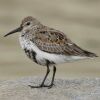
At #4, we have the Dunlin bird that has a curved tip at the end of its bill! Although it’s pretty small (around the size of a robin), you’ll see how much it resembles a shorebird. And you’ll also understand why the curved bill is so useful to them.
The first time I came across the Dunlin birds was in wet tundra. And I wasn’t surprised too, since they’re a fan of wetland environments. It wasn’t just one but many, since they have a slow pace and almost always walk in flocks! It was a delight to see them use their curved tips to peck through the mud. They are quite skilled at foraging not just in the day, but at night as well.
So what is their diet made of? When I first saw them, I could see them plucking out insects from the mud. Worms are their favorite but they also run off to the coast during winter and cooler seasons to catch small fish. They also find other creatures there such as snails. But all in all, they can eat seeds and leaves too, so that makes them omnivorous!
The males court the females by using nest-making movements as rituals. Although they build their nests on the ground, they make sure it’s well out of sight for utmost safety. You are most likely to find a nest under a clump of grass or even below a hummock. Although both the males and females are involved in nest-building, it’s the female that finishes the nest. You can find the males singing while hovering around and offering courtship!
Also, did you know that the young ones can start flying in as little as 19 days. They can even feed themselves, isn’t that cool?
fun fact
dunlin's name
The name 'Dunlin' seems to fit the bird quite well, doesn't it? 'Dun' means 'brown-gray' and 'lin' stands for little. It sure is a little brown-grayish bird!
5. Dickcissel
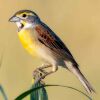
This sparrow-like but relatively larger bird is on our #5! The Dickcissel was originally from the Atlantic but it completely vanished from there by the end of the 19th century! And guess what? Now you can see them in masses in South America!
And you can witness thousands of them migrating when it’s Fall. If you’ve ever seen a miniature meadowlark, a Dickcissel is quite the same with those familiar yellow and brown colors. When I was on a birdwatching trip in the middle of the continent, I saw them foraging in flocks while they were nesting. But when they’re not nesting, they usually move towards low vegetation to find food. And they tend to wander quite a lot, so you find them in the East of the United States too!
Their diet is mostly all insects, at least for the summer you’ll be able to watch them eating beetles, grasshoppers, crickets, etc. As for the other seasons, they’re all about seeds, grain, and weeds - so a much more vegetarian diet!
By the way, do you want to know another interesting fact about their appearance? The females are duller, whilst the males have a breast that’s bright yellow, with a black patch on the throat.
Also, make sure you have a knack for detecting the bird’s sound. The Dickcissel makes song notes that subtly matches with its name, kind of like dick-dick-cissel. The sound starts sharp but then becomes hazy as it descends, like a soft buzz or hiss gradually fading away.
fun fact
polygyny
Did you know what dickcissels are polygynous? The breeding system is not that common in birds and thus makes the dickcissels stand out. The males even sing to defend their nesting territory.
6. Dusky Flycatcher
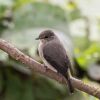
Up next we have the Dusky Flycatcher at #6. Its cute physique with brown feathers and intermediate size are quite the camouflage against wooden backdrops of trees!
These birds have a great appetite for insects. You’ll find them feasting on butterflies, bees, wasps, and I even saw it eating a grasshopper once! They sit on the perches and wait for their prey to emerge before flying out to capture them. They usually don’t hide away in the branches so you can find them easily when they’re sitting on exposed branches, waiting to eat. If you want to spot them by sound, listen to any signs of sharp calls. They are a series of a variety of cute little chirps!
fun fact
a hopping display
In courtship, the Dusky Flycatcher puts on quite a show. You'll find both the male and the female hopping on the branches and perches. And while they're at it, they flutter their wings too! The male also sings to defend its nest and territory!
7. Dusky-capped Flycatcher
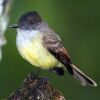
On #7 we have yet another flycatcher: The Ducky-capped Flycatcher! In the summer, you can find them quite a lot in Arizona and New Mexico, in pine-oak forests and canyons.
Just like the dusky flycatcher, the dusky-capped flycatcher also often catches insects in mid-air! Speaking from my personal experience, this bird often sits on the perch and spies on its prey before taking any action. When it sees a potential insect, it flies out into the scene and hovers around for some time before capturing its meal. Better yet, it never returns to the same perch and goes to sit on another to enjoy its food.
So where do they differ from the flycatcher? Well, it all comes down to their nesting habits. They make good use of tree cavities for their nests and don’t mind using a hole that has been made by a woodpecker either. If you want to see the nest of the Dusky-capped Flycatcher, look up very high as it can be at a point as high as 60 feet above the ground!
Although their yellow tummies are a prominent feature, you can spot them track them using their sound. Listen if you can find a ‘huit’ that rises and falls very often and then slowly turns softer. Their call is like a whistle but it sounds quite mournful though!
fun fact
go to low canyon areas
You can spot these birds along with their fellow Brown-crested flycatchers and Ash-throated flycatchers in low canyons.
8. Dusky Grouse
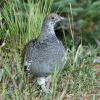
We have the Dusky Grouse at #8! And you’ll find that these fascinating birds are quite fond of the ground. They even build their nests there!
When I saw this bird in the summer, I was able to spot it more quickly. That’s because, during this season, it likes to forage on the ground. But in the winter, it loves to forage in the trees, which makes it more difficult to detect them of course! They also love areas that are heavily snowed, so imagine looking for them in heaps of snow!
So it’s better if you look out for them in the Spring, it’s the easiest to spot one then! Another bonus you’ll get is that the male dusky grouse usually put themselves on display during this season! They’re also more likely to make low-pitched hooting sounds - I’ve heard them myself! You’ll even see the males going on shirt flights while singing very deeply. They raise their tails and their neck feathers are fanned and spread, so as to reveal the bright skin underneath. If you want to look at its nest, it’s always on the ground and the female always leaves the male after mating!
PRO-TIP
The third-largest grouse
It's the third-largest grouse in North America, followed by the other two grouses, namely the Greater Grouse and the Gunnison Grouse.
9. Dovekie
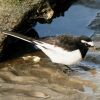
We have the lovely Dovekie at #9. And although it isn’t as common as others on the list, it’s still special. That’s because you’d need to head to the ocean to actually catch a glimpse of this beautiful black and white feathered creature!
So in which direction should you move? Your best bet is to go as far North as possible. It was the same with me, and I had even brought a spotting scope with me. It’s hard to detect these birds otherwise since many types of birds are around as well! January or February is the best time to find these birds enjoying the waters off the shore!
They also come towards the land area of, typically the eastern coast of North America as stranded birds. But this can only happen due to harsh winds when feeding becomes difficult for these birds. They’re the most abundant in Canada!
fun fact
did you know?
The Dovekie is also called the "bull bird" because of its rigid appearance even though it's small in size. This term is used for this bird in Newfoundland.
Conclusion
So there you go, the top 9 most common birds that start with D. Which one do you like the most? Have you seen any of these previously? If not, which ones do you plan on finding and watching first? Do remember the tips that I’ve given you and best of luck for your birdwatching journey! Oh, and if you’re looking for more common birds starting with other letters, then check out this post on the most common birds starting with the letter E:
16 Birds that Start with E
Did you know that out of 750 most common birds in the USA and Canada, there are 16 that start with the letter E? Here's the complete list of these birds!

By David A. Swanson
Bird Watching USA
My name is David and I'm the the founder of Bird Watching USA! I started Bird Watching with My father-in-law many years ago, and I've become an addict to watching these beautiful creatures. I've learnt so much over about bird watching over the years that I want to share with the world everything I know about them!

David A. Swanson
Bird Watching USA
My name is David and I'm the the founder of Bird Watching USA! I started Bird Watching with My father-in-law many years ago, and I've become an addict to watching these beautiful creatures. I've learnt so much over about bird watching over the years that I want to share with the world everything I know about them!

